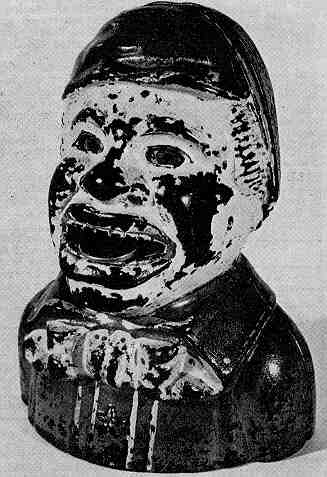Hindu Bank
by F.H. Griffith - HOBBIES Magazine - February, 1955
 The Hindu Bank, No. 35 in our numerical classification, brings us to another
group of mechanical banks. This group is the head or bust type of mechanical bank and the
Hindu is the first of its type to be written up in the articles.
The Hindu Bank, No. 35 in our numerical classification, brings us to another
group of mechanical banks. This group is the head or bust type of mechanical bank and the
Hindu is the first of its type to be written up in the articles.
The bust group is quite interesting and very different than the other mechanical banks. In this group are the Jolly Nigger, Bill E. Grin, Humpty Dumpty, Uncle Tom, and a number of the English banks including Aunt Dinah. Most of these banks roll their eyes and move their tongues. In addition some have an arm and hand extended to receive the coin. Also in most cases the coin enters the bank through the mouth.
The Hindu is the most desirable and one of the rarest of the bust group. It was patented January 24, 1882 under Patent No. 252,607 by Louis Kyser and Alfred C. Rex of Philadelphia, Pa. It was also manufactured by their concern, the Kyser & Rex Manufacturing Company. It’s interesting to note that the bank varies a bit from the mechanism as covered by the patent papers, however, the general idea is about the same. Also of interest is the fact that the same patent papers were used to cover both types of the Uncle Tom Bank. These two banks are quite different as to mechanism in that one sticks his tongue out to receive the coin while the eyes roll upward, and in the other the coin is placed on the tongue inside the mouth and the eyes roll downward. Then too, of course, one has coat lapels with the name ‘Uncle’ on one lapel and ‘Tom’ on the other.
Apparently the Hindu Bank was made by utilizing the pattern of the Uncle Tom Bank without coat lapels, the turban and fez being added to the pattern with other minor changes. We can safely assume that Uncle Tom was made before the Hindu as the sketch of the bank in the patent papers does not show any kind of hat or head gear.
The bank shown was recently obtained by the writer through the good help of a stamp collector, Mr. Chas. Pfahl of Akron, Ohio. He in turn had purchased it from an antique picker who had found the bank locally in a home.
The paint is in good condition for this particular bank even though, as can be seen in the picture, it is rather worn on the cheeks, nose and chin. Apparently this type of bank was subject to rough play and tossed into toy boxes and the like. It is not easily broken as is the case with many of the banks and, therefore, the paint got the worst of it. The bank is very colorful and painted as follows: The jacket is red with yellow striping and the tie is yellow with red dots. His face is white with red lips and tongue, and his turban blue with a yellow tassel. His eyes are gray with black pupils.
The specimen pictured is all original with the exception of the base plate. Fortunately this is not too important as the plate is practically the same as that on the Uncle Tom Bank and not too difficult to obtain. The same lock type coin trap with the initials ‘U.T.’ used on the Uncle Tom Bank is also used on the Hindu, and the writer had a spare original trap which was utilized.
The bank operates as follows: A coin is placed in the mouth to partially rest on the tongue. Then a lever in the back of the head is pressed down and the tongue swings back dropping the coin into the bank. The eyes meantime roll downward. Releasing the lever returns the eyes and tongue to their original position. Coins are removed by means of the key locking coin trap in the base plate.
The Hindu is a nice little mechanical bank and a fine addition to any collection. They don’t turn up very often and trying to find one can be a real problem.
